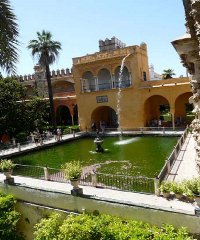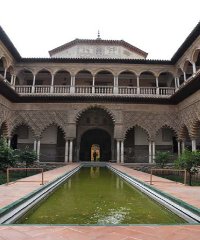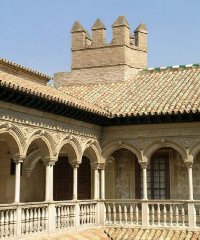- Presentation
- Programme
- Registration
- Information
- Contact
Real Alcázar
Documents
-
Ficha completa (57.01 MB)
Fichas del Catálogo del Real Alcázar. Plan Especial de Protección del Sector 6 "Reales Alcázares", aprobado provisionalmente en fecha 1 de junio de 2012.
- Índice (5.3 MB)
- Apeadero (1.38 MB)
- Casa del Asistente (1.21 MB)
- Casa del Militar (1.07 MB)
- Cenador del León (6.01 MB)
- Cuarto del Sol (1.04 MB)
- Estanque de Mercurio (1.32 MB)
- Jardín de la Alcubilla, Cuarto de la China y Jardín del Chorrón (1.22 MB)
- Jardín de la Danza (1.35 MB)
- Jardín de la Galera (1.22 MB)
- Jardín de las Damas, Jardín del Laberinto y Jardines de Carlos V (1.9 MB)
- Jardín de las Flores (1.03 MB)
- Jardín de los Pintores (1.31 MB)
- Jardín de los Poetas y restos de la Antigua Huerta del Retiro (1.57 MB)
- Jardín de Troya (1.16 MB)
- Jardín Inglés (1.67 MB)
- Jardines del Marqués de la Vega-Inclán (1.62 MB)
- Muralla Alcázar Recinto I (3.16 MB)
- Muralla Alcázar Recinto II (3.05 MB)
- Muralla Alcázar Recinto III (3.89 MB)
- Muralla Islámica (3.17 MB)
- Pabellón de Carlos V (1.25 MB)
- Palacio de Don Pedro I (2.03 MB)
- Palacio Gótico, Jardín del Crucero y Baños de Doña María (1.66 MB)
- Patio de la antigua Casa de Contratación (1.45 MB)
- Patio de la Montería (1.8 MB)
- Patio del León (1.42 MB)
- Patio del Príncipe (1.09 MB)
- Sala de la Justicia, Patio del Yeso y Cuarto del Maestre (1.4 MB)
- Sala del Almirante (1.26 MB)
The Royal Alcázar of Seville is the oldest royal palace in Europe still currently in use. Its historic background and the spectacular beauty of its buildings and gardens make it one of the most interesting and seductive monuments in Spain.
The Royal Alcázar is composed of different palatial buildings which, as with the Cathedral, represent a variety of architectural styles and eras. The wall surrounding the palatial complex dates from the Almohad period. The complex itself is composed of a series of residential buildings situated around the Patio de las Doncellas and the Patio de las Muñecas, as well as a series of gardens also demonstrating a variety of styles – from simple Almohad gardens to Renaissance-style gardens around the Estanque de Mercurio and Galería del Grutesco. Another of the notable elements in this network of gardens is the Cenador de la Alcoba, or Pavilion of Charles V, a recreational building uniting both Mudéjar and Renaissance elements.
First and foremost, the Royal Alcázar complex offers a wonderful glimpse into Almohad art of Moroccan origin with its sober, strong and highly geometric style. However, the Alcázar is also a testament to the cultural symbiosis between the Orient and Occident taking place in Spain at the time, as perfectly exemplified by the Mudéjar style of many of the complex’s components.



In 913 during the Moorish period, Abd-al-Rahman III built a fortified palace whose remains can still be seen in the oldest parts of the Alcázar. In the 11th century, Al-Mutamid, ruler of the Taifa of Seville, constructed what he called the Blessed Alcázar. The Almohad caliphs Abu Ya’qub Yusuf and Abu Yusuf Ya’qub al-Mansur also built their residences in what is known today as the Patio del Yeso.
Following the Christian Reconquista, Ferdinand III of Castille chose the Alcázar as his place of residence, where he lived until his death in 1252. His son Alfonso X, who also lived there, ordered the construction of the Gothic Palace, which later became the setting for legends about the romantic lives of Sancho IV, Alfonso XI and, most importantly, Peter I, who ordered the construction of the Mudéjar palace constituting the main part of the complex which we see today.
The Catholic Monarchs (Isabella I of Castille and Ferdinand II of Aragon) and the Austrians carried out further adaptations and reforms to various palaces and gardens. The Royal Alcázar was the setting of the wedding of Emperor Charles V and Isabella of Portugal in 1526, as well as of the court of Philip V from 1729 to 1733. As the Alcázar was also used as a governor’s residence, the illustrious Pablo de Olavide lived there between 1767 and 1775. The exterior gardens were designed at the end of 19th century and the beginning of the 20th century. Today the Royal Alcázar continues to be an official residence of the Spanish Monarchy.
The Royal Alcázar is protected as an Area of Historical-Cultural Interest (Zona de Interés Histórico-Cultural), approved by the Spanish Decree of 3 June 1931 and published in the Spanish Official Bulletin on 4 June 1931.
Source: "Sevilla", Juan Pablo Navarro. Editorial Maratania.
